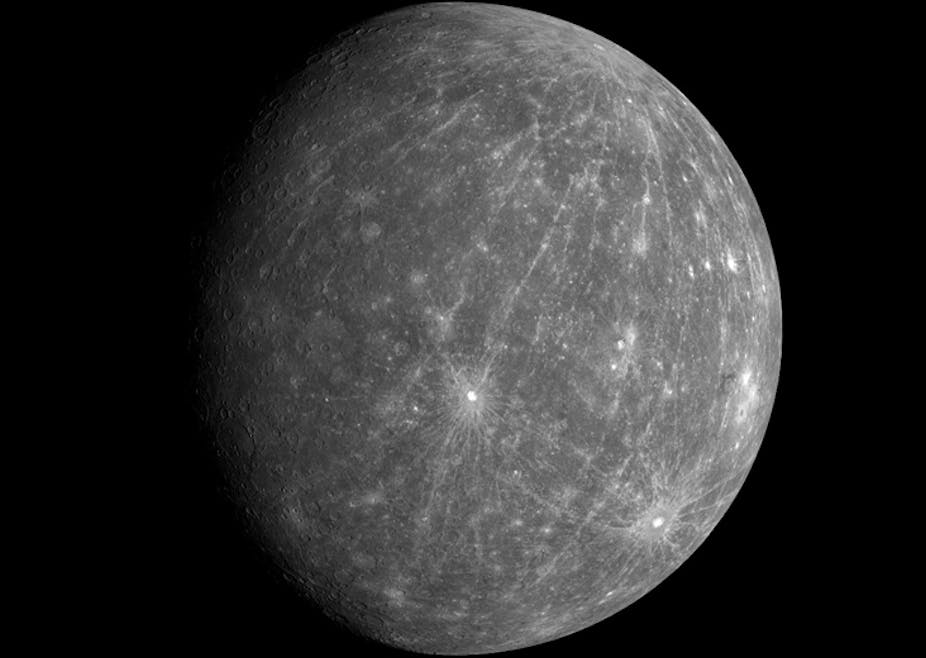Whenever I’m telling students or people at conferences about Mercury, I always describe it as the “heavy metal” planet. Many things on this closest planet to the sun are extreme, from its 88-Earth-day year to the massive temperature variation at its surface (-170ºC to +400ºC).
Of course Mercury also gets it’s heavy metal image from the fact that its iron and nickel core makes up 42% of the planet’s volume. Compared to Earth – which has a metallic core that contributes only 17% to the planet’s volume – Mercury is quite a dense little planet.
But now, Mercury’s reputation as the heavy metal planet might have been dented somewhat. NASA scientists this morning (AEST) announced the discovery of enough water ice at Mercury’s north pole to fill the Dead Sea (or cover Washington DC).
It’s long been speculated that ice could exist at Mercury’s poles, because the planet doesn’t have much of an axial tilt. That is, the angle between Mercury’s rotational axis at the north pole and a line that’s perpendicular to its orbital plane is negligible.
With very little axial tilt Mercury’s poles are hidden from the sun all (short) year round and hence temperatures can be as low as -170ºC.
(By way of contrast, Earth’s axial tilt is roughly 23º and it’s this difference that gives us the variation of the seasons.)

This new evidence for water ice, presented in three papers on Science Express, comes courtesy of the MESSENGER (MErcury Surface, Space ENvironment, GEochemistry and Ranging) spacecraft. This NASA mission has been investigating Mercury since 2008, but it was only in 2011 that the spacecraft entered orbit around the planet.
The water was discovered by MESSENGER by measuring the amount of neutrons being emitted from the surface of the planet (see video below). These neutrons are normally emitted from a planet’s surface after being hit by cosmic radiation from space.
But, any hydrogen near the surface of a planet (such as that found in water) acts as a blanket for the neutrons, and stops them from being emitted. MESSENGER measured a lack of neutrons being emitted from Mercury’s north pole, suggesting water ice could be hiding there.
So where did this water come from? Well, according to NASA, there are two potential sources: from water-carrying meteorites that have bombarded Mercury over the years, and “planetary outgassing” which could have brought water from the planet’s interior to the surface (although this second explanation is still speculative).
Also intriguing about MESSENGER’s new findings are the hints of organic molecules that could exist in the dark patches seen in radar observations of Mercury’s polar regions (see image below right).

And so to the question everyone’s bound to ask: will we find life on Mercury?
Well, on the border between the icy poles and the main dry body of Mercury, there may be a small corridor where an extremely hardy life form could exist. That said, I don’t imagine many scientists would be willing to stake much on that slim possibility.
But what the discovery of water ice and hints of hydrocarbons do suggest is that a human exploration base on Mercury could be a real possibility in the decades to come.
In the meantime NASA will direct MESSENGER to observe Mercury’s north pole in greater detail to see what else we can learn.
I like to think that the planets have a bit of a tune to them as they whiz round the sun. To that end, I’ve always had Motörhead’s seminal heavy metal track “Ace of Spades” in mind for tough little Mercury.
Now that Mercury’s heavy metal status seems to have been somewhat *cough* watered down, I might have to pick a different song.
Further reading and viewing:

